高中英语必修三第五单元教案
- 格式:doc
- 大小:72.50 KB
- 文档页数:10
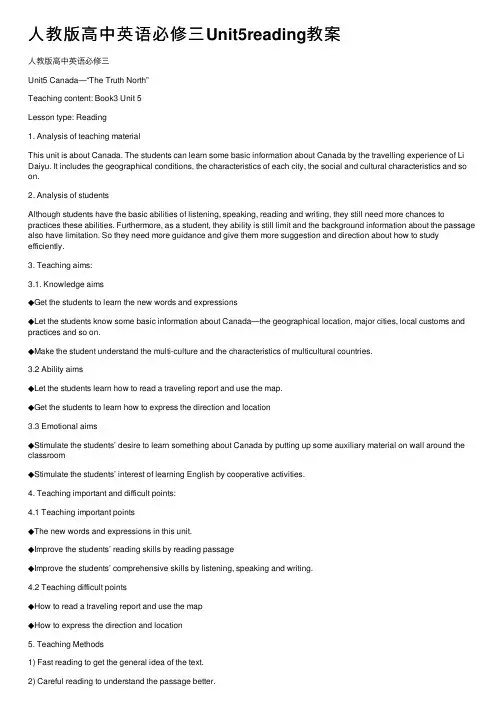
⼈教版⾼中英语必修三Unit5reading教案⼈教版⾼中英语必修三Unit5 Canada—“The Truth North”Teaching content: Book3 Unit 5Lesson type: Reading1. Analysis of teaching materialThis unit is about Canada. The students can learn some basic information about Canada by the travelling experience of Li Daiyu. It includes the geographical conditions, the characteristics of each city, the social and cultural characteristics and so on.2. Analysis of studentsAlthough students have the basic abilities of listening, speaking, reading and writing, they still need more chances to practices these abilities. Furthermore, as a student, they ability is still limit and the background information about the passage also have limitation. So they need more guidance and give them more suggestion and direction about how to study efficiently.3. Teaching aims:3.1. Knowledge aims◆Get the students to learn the new words and expressions◆Let the students know some basic information about Canada—the geographical location, major cities, local customs and practices and so on.◆Make the student understand the multi-culture and the characteristics of multicultural countries.3.2 Ability aims◆Let the students learn how to read a traveling report and use the map.◆Get the students to learn how to express the direction and location3.3 Emotional aims◆Stimulate the students’ desire to learn something about Canada by putting up some auxiliary material on wall around the classroom◆Stimulate the students’ interest of learning English by cooperative activities.4. Teaching important and difficult points:4.1 Teaching important points◆The new words and expressions in this unit.◆Improve the students’ reading skills by reading passage◆Improve the students’ comprehensive skills by listening, speaking and writing.4.2 Teaching difficult points◆How to read a traveling report and use the map◆How to express the direction and location5. Teaching Methods1) Fast reading to get the general idea of the text.2) Careful reading to understand the passage better.3) Discussion to help the students understand better what they’ve learned and to use the knowledge they’ve learned in this period.。
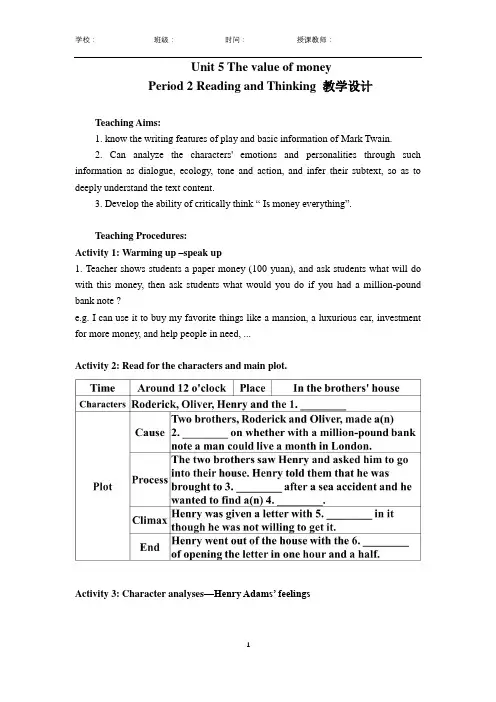
Unit 5 The value of moneyPeriod 2 Reading and Thinking 教学设计Teaching Aims:1. know the writing features of play and basic information of Mark Twain.2. Can analyze the characters' emotions and personalities through such information as dialogue, ecology, tone and action, and infer their subtext, so as to deeply understand the text content.3. Develop the ability of critically think “ Is money everything”.Teaching Procedures:Activity 1: Warming up –speak up1. Teacher shows students a paper money (100 yuan), and ask students what will do with this money, then ask students what would you do if you had a million-pound bank note ?e.g. I can use it to buy my favorite things like a mansion, a luxurious car, investment for more money, and help people in need, ...Activity 2: Read for the characters and main plot.Activity 3: Character analyses—Henry Adams’ feelingsActivity 4: Reading for detailed feelings1) Who? Me, sir ?(surprised)2) Well, I can’t say that I have any plans. As a matter of fact, I l anded in Britain by accident.(anxious)3) I’m afraid I don’t quite follow you, sir.( puzzled/confused)4) Well, it may seem lucky to you but not to me ! if this is your idea of some kind of joke, I don’t think it’s very funny. (angry)5) Well, why don’t yo u explain what this is all about ?(curious)Activity 5: answer the following questions1. How does Henry want the brothers to help him?2. Why do you think Henry does not want the brothers' charity?3. Why do you think the brothers chose Henry for their bet?Activity 6: Critical Thinking:Debate: Divide students into two groups: positive side and negative side. And think the following questions.Is money so important? Some people say money is everything. But some people still think that money cannot bring them everything.What do you think of this?。
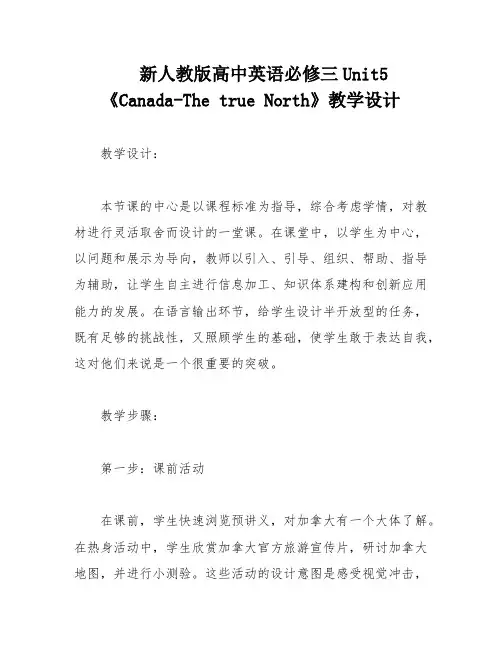
新人教版高中英语必修三Unit5《Canada-The true North》教学设计教学设计:本节课的中心是以课程标准为指导,综合考虑学情,对教材进行灵活取舍而设计的一堂课。
在课堂中,以学生为中心,以问题和展示为导向,教师以引入、引导、组织、帮助、指导为辅助,让学生自主进行信息加工、知识体系建构和创新应用能力的发展。
在语言输出环节,给学生设计半开放型的任务,既有足够的挑战性,又照顾学生的基础,使学生敢于表达自我,这对他们来说是一个很重要的突破。
教学步骤:第一步:课前活动在课前,学生快速浏览预讲义,对加拿大有一个大体了解。
在热身活动中,学生欣赏加拿大官方旅游宣传片,研讨加拿大地图,并进行小测验。
这些活动的设计意图是感受视觉冲击,激发研究兴趣,抓住学生对加拿大想要了解的兴趣,转化为地图上重要地理坐标的梳理,快速输入加拿大的基本信息,做一个初步了解。
第二步:阅读活动在阅读活动中,学生进行速读课文,完成相关任务,预测文章内容并补充完整句子,将课文段落大意连线,读取课文获取细节信息。
这些活动旨在提高学生的研究技能,特别是总结和理解文本。
同时,通过任务为导向,通过小组讨论和展示,建构知识体系,取长补短,使学生获得表达自我的成就感,从而内化为研究的动力。
教学目标:本节课的知识目标是让学生了解与旅行和加拿大有关的词汇、短语和句子结构。
能力目标是提高学生的研究技能,特别是总结和理解文本,同时练学生的口语表达能力。
情感目标是让学生欣赏多元文化现象,更好地理解国家之间的差异。
In this article。
we will XXX Canada。
XXX。
Canada is known for its vast landscapes。
friendly people。
and diverse XXX discuss some of the must-visit places in Canada and the best XXX.Firstly。
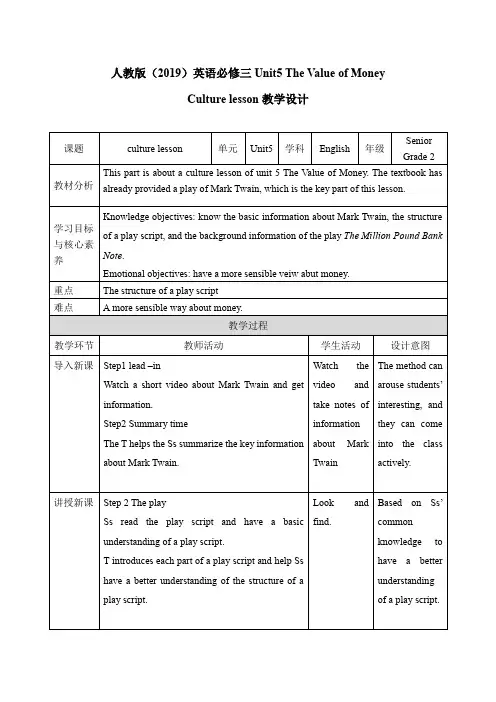
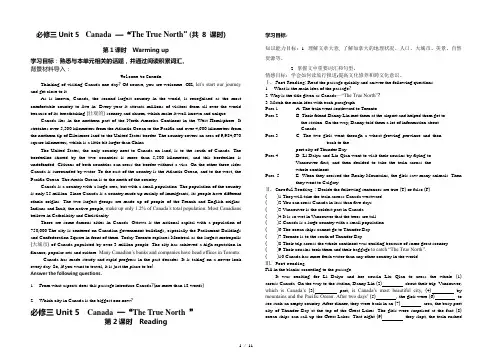
必修三Unit 5 Canada —“The True North” (共8 课时)第1课时Warming up学习目标:熟悉与本单元相关的话题,并通过阅读积累词汇。
背景材料导入:Welcome to CanadaThinking of visiting Canada one day? Of course, you are welcome. OK,let’s start our journey and get close to it.As is known, Canada,the second largest country in the world,is recognized as the most comfortable country to live in. Every year it attracts millions of visitors from all over the world because of its breathtaking (壮观的) scenery and charm, which make it well-known and unique.Canada lies in the northern part of the North America Continent in the West Hemisphere. It stretches over 5,500 kilometers from the Atlantic Ocean to the Pacific and over 4,600 kilometers from the northern tip of Ellesmere land to the United States border. The country covers an area of 9,984,670 square kilometers, which is a little bit larger than China.The United States,the only country next to Canada on land,is to the south of Canada. The borderline shared by the two countries is more than 5,500 kilometers, and this borderline is undefended. Citizens of both countries can cross the border without a visa. On the other three sides Canada is surrounded by water. To the east of the country is the Atlantic Ocean, and to the west, the Pacific Ocean. The Arctic Ocean is to the north of the country.Canada is a country with a large area, but with a small population. The population of the country is only 25 million. Since Canada is a country made up mainly of immigrants, its people have different ethnic origins. The two largest groups are made up of people of the French and English origins. Indians and Inuit, the native people,make up only 1.2% of Canada’s total population. Most Canadians believe in Catholicity and Christianity.There are some famous cities in Canada. Ottawa is the national capital with a population of 750,000.The city is centered on Canadian government buildings, especially the Parliament Buildings and Confederation Square in front of them. Today Toronto replaces Montreal as the largest metropolis (大城市) of Canada populated by over 3 million people. The city has achieved a high reputation in finance, popular arts and culture. Many Canadian’s banks and companies have head offices in Toronto.Canada has made steady and rapid progress in the past decades. It is taking on a newer look every day. So, if you want to travel, it is just the place to be!Answer the following questions.1.From what aspects does this passage introduce Canada?(no more than 18 words)2.Which city in Canada is the biggest one now?必修三Unit 5 Canada —“The True North ”第2课时Reading 学习目标:知识能力目标:1. 理解文章大意, 了解加拿大的地理状况、人口、大城市、美景、自然资源等。
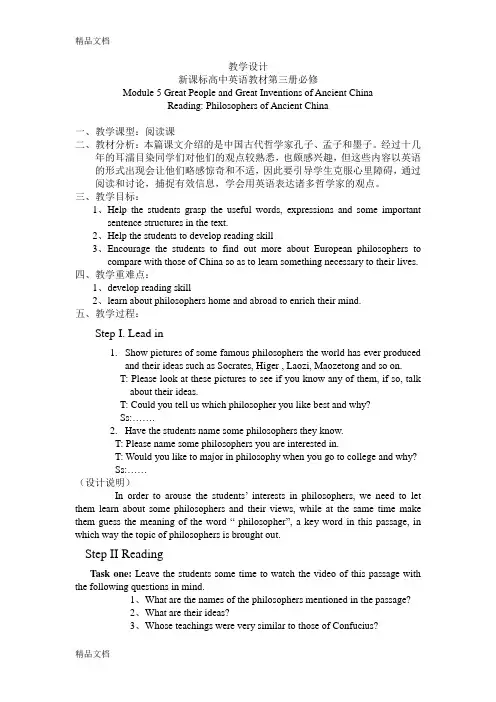
教学设计新课标高中英语教材第三册必修Module 5 Great People and Great Inventions of Ancient ChinaReading: Philosophers of Ancient China一、教学课型:阅读课二、教材分析:本篇课文介绍的是中国古代哲学家孔子、孟子和墨子。
经过十几年的耳濡目染同学们对他们的观点较熟悉,也颇感兴趣,但这些内容以英语的形式出现会让他们略感惊奇和不适,因此要引导学生克服心里障碍,通过阅读和讨论,捕捉有效信息,学会用英语表达诸多哲学家的观点。
三、教学目标:1、Help the students grasp the useful words, expressions and some importantsentence structures in the text.2、Help the students to develop reading skill3、Encourage the students to find out more about European philosophers tocompare with those of China so as to learn something necessary to their lives.四、教学重难点:1、develop reading skill2、learn about philosophers home and abroad to enrich their mind.五、教学过程:Step I. Lead in1.Show pictures of some famous philosophers the world has ever producedand their ideas such as Socrates, Higer , Laozi, Maozetong and so on.T: Please look at these pictures to see if you know any of them, if so, talkabout their ideas.T: Could you tell us which philosopher you like best and why?Ss:…….2.Have the students name some philosophers they know.T: Please name some philosophers you are interested in.T: Would you like to major in philosophy when you go to college and why?Ss:……(设计说明)In order to arouse the students’interests in philosophers, we need to let them learn about some philosophers and their views, while at the same time make them guess the meaning of the word “ philosopher”, a key word in this passage, in which way the topic of philosophers is brought out.Step II ReadingTask one: Leave the students some time to watch the video of this passage with the following questions in mind.1、What are the names of the philosophers mentioned in the passage?2、What are their ideas?3、Whose teachings were very similar to those of Confucius?4、Why did Mencius resigned?5、What is the difference between the views of Confucius and that ofMozi?T: Now I ’like you to watch the video with some questions in mind to get a general idea of the whole passage.Ss:……….(设计说明)In learning a foreign language, listening should come before reading, especially for high school students who have no time to communicate with foreigners, and with some questions in mind while listening is helpful for them to grasp the main idea of the passage and avoid blind listening.Task two:Skimming1.Leave the students five minutes to skim the passage and pick out the topics sentences of each paragraphT. Now that you have got some idea about these philosophers, next go over the text quickly to pick out the topic sentences of each paragraph.2.Show the topic sentences on the computer screen(1)Confucius is the philosopher whose influence has been the greatest.(2)Mencius was a thinker whose teachings were very similar to those ofConfucius.(3)Mozi founded the philosophy called Mohism.(设计说明)Going through the passage quickly to find the topic sentences is to help them improve their reading skill and in the long run to learn writing.Task three:Scanning: Let the students read the passage more carefully and finish the following exercise.T: Please read the text in detail this time and then carry out the following activities.1. fill in the blanks without looking at your books, each blank with one word.(1)Confucius is the ________whose influence has been the greatest.(2)Confucius ________the importance of kindness.(3)Mencius was a thinker whose _______were very similar to those ofConfucius.(4)However, when he saw that the ruler was not following his advice, he_______.(5)Mozi was another teacher who was very _________.(6)He became famous for his unusual clothes and ____________.2.Choose the right answers:(1). Mozi spent many year trying to find a state in that_______.A.He believed that men were not equal.B.His idea of love was different from the Confucian idea of kindness.C.He supported the idea of war.D.He wanted people to follow his teachings(2) Which of the following idea is from The Book of MenciusA.People were less important than rulersB.The people should be well treated by the governmentC.If the government were tough, the people would be good.D.The people should be treated badly(3) It can be inferred that the author of the passage is_______.A.is in favour of these philosophersB.doesn’t support the ideas of the philosophersC.the passage doesn’t implyD.is against the ideas of the philosophers3.Show the answers on the computer screen of excises 1and2.Excise1. 1. fill in the blanks without looking at your books, each blank with one word.(1) Confucius is the philosopher whose influence has been the greatest.(2) Confucius stressed the importance of kindness.(3) Mencius was a thinker whose teachings were very similar to those ofConfucius.(4) However, when he saw that the ruler was not following his advice, heresigned.(5) Mozi was another teacher who was very influential.He became famous for his unusual clothes and behaviour.Excise 2. D B C(设计说明)To read the passage in detail is to have a further understanding of the text.The above two excises are designed to help the students search information and give a summary of the passage.Step III. DiscussionHave the students give a discussion of some foreign philosophers and their teachings (prepared before class as a homework to surf the internet) in group of four within about 15 minutes with each group handing in their final report after class.(设计说明)The materials of the discussion have to be prepared beforehand so that the students will spend time collecting them, which can raise their ability of finding out information, while the discussion is a sort of group activity which can help them learn to cooperate with each other.Step IV Language points discussionHold a discussion about the usage of some important words, phrases and sentence structures.T: Now we have finished the reading part of the passage. Well, let’s have a discussion about the language points of this passage. First look at the first paragraph, anyone volunteer to point out important words, phrases or sentences structures you think important…….Ss: be at war with…..( The following Words and expressions and sentence structures should bepointed out by the students and their usage should be discussed, the teacherhas to give some further explanation and examples if necessary) Words and expressions:stress; resign; adviser; influential; principle; be at war with; be brought up;be similar t o; in some ways; man; human beings….Sentence structures:(2)But it was a time when there were many great philosophers.(3)Mencius believed that the reason why man is different from animal isthat man is good.(4)(5)As a result, he spent many years trying to find a state where peoplewould follow his teachings.(设计说明)Learning to use the words , expressions and sentence structure is one of the important skills for the students. To teach oneself and hold a discussion is a good way to grasp them, and to a certain extent help the teacher a lot in teaching, there is always something the teacher has n’t prepared.Step IV. HomeworkT: Today we have completed learning the words, phrases and sentence structures of the passage and developed reading skill, so the homework today should be making good use of what has been learned in this passage, that is , write a short passage about a famous philosopher you know in about 200 words.(设计说明)The best way to learn a language well is to use it in real life, so writing about something the students are familiar with is helpful to improve their skill inEnglish.。
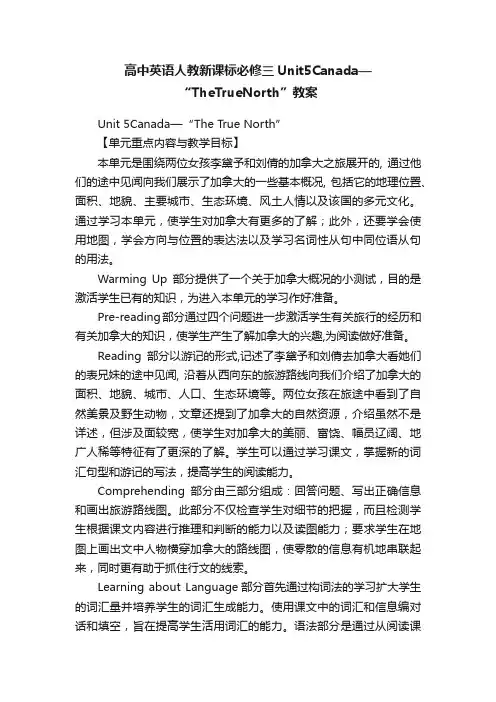
高中英语人教新课标必修三Unit5Canada—“TheTrueNorth”教案Unit 5Canada—“The True North”【单元重点内容与教学目标】本单元是围绕两位女孩李黛予和刘倩的加拿大之旅展开的, 通过他们的途中见闻向我们展示了加拿大的一些基本概况, 包括它的地理位置、面积、地貌、主要城市、生态环境、风土人情以及该国的多元文化。
通过学习本单元,使学生对加拿大有更多的了解;此外,还要学会使用地图,学会方向与位置的表达法以及学习名词性从句中同位语从句的用法。
Warming Up部分提供了一个关于加拿大概况的小测试,目的是激活学生已有的知识,为进入本单元的学习作好准备。
Pre-reading部分通过四个问题进一步激活学生有关旅行的经历和有关加拿大的知识,使学生产生了解加拿大的兴趣,为阅读做好准备。
Reading部分以游记的形式,记述了李黛予和刘倩去加拿大看她们的表兄妹的途中见闻, 沿着从西向东的旅游路线向我们介绍了加拿大的面积、地貌、城市、人口、生态环境等。
两位女孩在旅途中看到了自然美景及野生动物,文章还提到了加拿大的自然资源,介绍虽然不是详述,但涉及面较宽,使学生对加拿大的美丽、富饶、幅员辽阔、地广人稀等特征有了更深的了解。
学生可以通过学习课文,掌握新的词汇句型和游记的写法,提高学生的阅读能力。
Comprehending部分由三部分组成:回答问题、写出正确信息和画出旅游路线图。
此部分不仅检查学生对细节的把握,而且检测学生根据课文内容进行推理和判断的能力以及读图能力;要求学生在地图上画出文中人物横穿加拿大的路线图,使零散的信息有机地串联起来,同时更有助于抓住行文的线索。
Learning about Language部分首先通过构词法的学习扩大学生的词汇量并培养学生的词汇生成能力。
使用课文中的词汇和信息编对话和填空,旨在提高学生活用词汇的能力。
语法部分是通过从阅读课文中找例句然后采用造句的练习形式教同位语从句。

Unit 5 Canada…“The True North”教学重点1.Let students read the passage and learn about the geography, population, main cities, natural beauty and natural resources of Canada.2.Get students to learn different reading skills.教学难点1.Develop students' reading ability.2.Enable students to learn about some basic information and talk about Canada.三维目标知识目标1.Get students to learn the useful new words and expressions in this part.2.Let students learn the knowledge of Canada.能力目标1.Develop students' reading ability and let them learn different reading skills.2.Let students learn how to read a traveling report and how to use a map.3.Enable students to learn about some basic information and talk about Canada.情感目标1.Stimulate students' interest in learning about foreign countries.2.Develop students' sense of cooperative learning.教学过程—Step 1 Leading-in and warming upShow the students two pictures, and ask them who are they and where are they from?Mark Rowswell 大山Norman Bethune 白求恩T: Today we will learn something about Canada. To check how much do you know about Canada, now we will do a small quiz. Please do the quiz on your paper.1.What language (s) do Canadians speak ?A.EnglishB.English & GermanC.English & FrenchD.English & Spanish2.What is the capital of Canada?A.VancouverB.TorontoC.CalgaryD.Ottawa3.What is the national animal of Canada?A.BeaverB. Grizzly bearC. Polar bearD. Penguin4.What is the Canadian leader called?A.PresidentB.Prime MinisterernorD.King5.How many Great Lakes are there in Canada?A. 4B. 3C. 5D. 6T: Through the quiz, I think you have known something about Canada, now let's follow two persons' step to enjoy the Canada's beautiful scenery. ---------------- present the title Canada—"The True North" on the blackboard.II.Fast readingRead the whole passage quickly, and finish the following two activities on your paper.【学生活动1】快速阅读文章,将各部分大意与其段落配对。
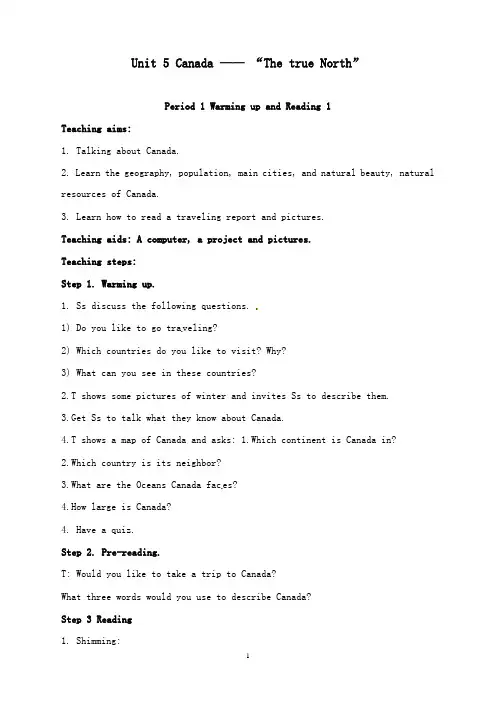
Unit 5 Canada ——“The true North”Period 1 Warming up and Reading 1Teaching aims:1. Talking about Canada.2. Learn the geography, population, main cities, and natural beauty, natural resources of Canada.3. Learn how to read a traveling report and pictures.Teaching aids: A computer, a project and pictures.Teaching steps:Step 1. Warming up.1. Ss discuss the following questions.1) Do you like to go tra veling?2) Which countries do you like to visit? Why?3) What can you see in these countries?2.T shows some pictures of winter and invites Ss to describe them.3.Get Ss to talk what they know about Canada.4.T shows a map of Canada and asks: 1.Which continent is Canada in?2.Which country is its neighbor?3.What are the Oceans Canada fac es?4.How large is Canada?4. Have a quiz.Step 2. Pre-reading.T: Would you like to take a trip to Canada?What three words would you use to describe Canada?Step 3 Reading1. Shimming:Get Ss to read the passage quickly and answer the following questions: 1) What is the passage mainly about?Sample:The passage is about a trip of two girls, and it tells us some information about Canada.2) What is “The Ture No rth”?Sample:“The True North” is the train that goes across Canada / the cross-Canada train.3) How many cities are mentioned in the text? What are they?Sample:Vancouver – Calgary—Thunder Bay—Toronto4) What do you know about each city?Vancouver :the warmest part of Canada; the most beautiful city in Canadamany Asian want to live there;the trees are extremely tall.the oldest and most beautiful forests in the worldCalgary:famous for StampedeCowboys come to compete in riding wild horses.good at working with animalsthey can win a lot of money in prizes.Thunder Bay:at the top end of the Great Lakes;very busy portclose to the centre of the country ,so that ocean ships can go there.2. Detailed reading:1) Get Ss to read the passage again and correct the following sentences.1. The girls went to Canada to see their relatives in Montreal.(in the East of Canada / on the Atlantic coast of Canada)2. Danny Lin was goi ng to drive them to Vancouver.(the train station to catch the cross-Canada train)3. You can cross Canada in less than five days by bicycle.(can’t)4. The girls looked out the windows and saw Native Indians and cowboys.(a grizzly bear, mountain goats and wild scenery)5. Thunder Bay is a port city in the south of Canada, near Toronto.(at the top end of the Great Lakes, near the center of the country)2) Listen to the tape and fill in the blanks from the text.Canada is _____ than the United States. It is the _______largest country in the world.It is _____ kilometers from coast to coast in Canada.The population of Canada is onl y slightly over_____________.Canada has _________ of the world’s fresh water, much of which is in the ___________.On the coast north of Vancouver some of the oldest and most beautiful _______ in the world still remain. It is so wet there that the trees are extremely ______.Period 2 Language points:1.Canada is a multicultural country like China. 加拿大像中国一样是一个多元化国家。
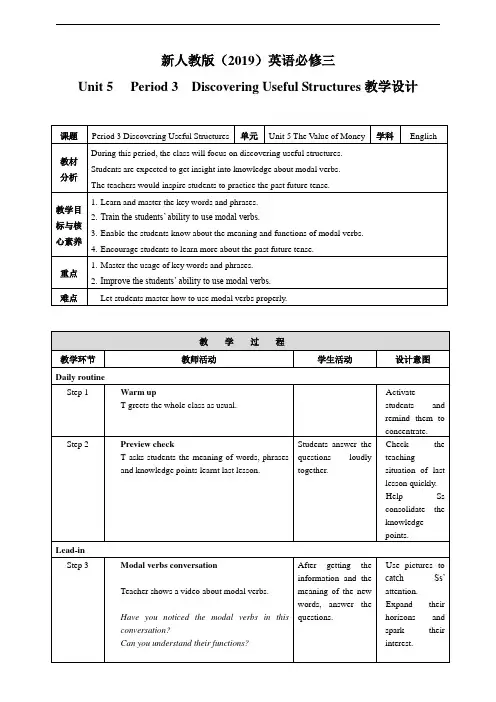
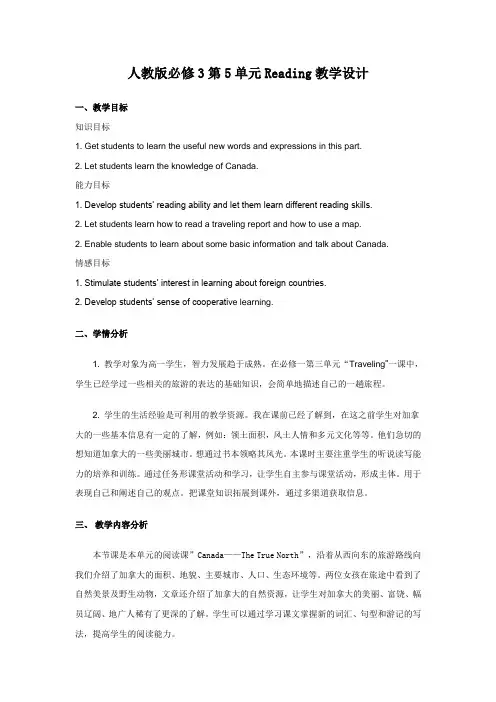
人教版必修3第5单元Reading教学设计一、教学目标知识目标1. Get students to learn the useful new words and expressions in this part.2. Let students learn the knowledge of Canada.能力目标1. Develop students’ reading ability and let them learn different reading skills.2. Let students learn how to read a traveling report and how to use a map.2. Enable students to learn about some basic information and talk about Canada.情感目标1. Stimulate students’ interest in learning about foreign countries.2. Develop students’ sense of cooperati ve learning.二、学情分析1. 教学对象为高一学生,智力发展趋于成熟。
在必修一第三单元“Traveling”一课中,学生已经学过一些相关的旅游的表达的基础知识,会简单地描述自己的一趟旅程。
2. 学生的生活经验是可利用的教学资源。
我在课前已经了解到,在这之前学生对加拿大的一些基本信息有一定的了解,例如:领土面积,风土人情和多元文化等等。
他们急切的想知道加拿大的一些美丽城市。
想通过书本领略其风光。
本课时主要注重学生的听说读写能力的培养和训练。
通过任务形课堂活动和学习,让学生自主参与课堂活动,形成主体。
用于表现自己和阐述自己的观点。
把课堂知识拓展到课外,通过多渠道获取信息。
三、教学内容分析本节课是本单元的阅读课”Canada——The True North”,沿着从西向东的旅游路线向我们介绍了加拿大的面积、地貌、主要城市、人口、生态环境等。
高中英语必修三第五单元篇一:高一英语必修3Unit5单元教案Unit 5 Canada ——“The true North”Period 1 Warming up and Reading 1Zhang Jiao Teaching aims:Knowledge aims:1. To learn some useful phrases and structures.2.Learn some geographical knowledge about Canada such as its population, main cities, natural beauty and natural resources. Ability aims:1. Learn how to read a traveling report and pictures.2. Enable students to express their opinions freely and bravely. Emotional aim:1. To make students interested in English by learning foreign country and its culture so as to make students not afraid of English learning. Teaching Important Points:1. Enable students grasp the useful phrases and structures.2. Enable students understand the passage.Teaching Difficult Points:1. How to make students understand the passage well.2. To grasp the important language points and use them properly. Teaching aids: A puter, textbooks and pictures.Teaching steps:Step 1. Warming up.1. Ss discuss the following questions.1) Do you like to go traveling?2) Which countries do you like to visit? Why?3) What can you see in these countries?2.T shows some pictures of winter and invites Ss to describe them.3.Get Ss to talk what they know about Canada.4.T shows a map of Canada and asks: 1.Which continent is Canada in?2.Which country is its neighbor?3.What are the Oceans Canada faces?4.How large is Canada?4. Have a quiz.Step 2. Pre-reading.T: Would you like to take a trip to Canada?What three words would you use to describe Canada?Step 3. Reading1. Shimming:Get Ss to read the passage quickly and answer the following questions:1) What is the passage mainly about?Sample:The passage is about a trip of two girls, and it tells us someinformation about Canada.2) What is ―The Ture North‖?Sample:―The True North‖ is the train that goes across Canada / the cross-Canada train.3) How many cities are mentioned in the text? What are they? Sample:Vancouver – Calgary—Thunder Bay—Toronto4) What do you know about each city?Vancouver :the warmest part of Canada; the most beautiful cityin Canada many Asian want to live there;the trees are extremely tall. the oldest and most beautiful forests in the worldCalgary:famous for StampedeCowboys e to pete in riding wild horses.good at working with animalsthey can win a lot of money in prizes.Thunder Bay:at the top end of the Great Lakes;very busy portclose to the centre of the country ,so that ocean ships can go there.2. Detailed reading:1) Get Ss to read the passage again and correct the following sentences.1. The girls went to Canada to see their relatives in Montreal. (in the East of Canada / on the Atlantic coast of Canada)2. Danny Lin was going to drive them to Vancouver.(the train station to catch the cross-Canada train)3. You can cross Canada in less than five days by bicycle. (can’t)4. The girls looked out the windows and saw Native Indians and cowboys.(a grizzly bear, mountain goats and wild scenery)5. Thunder Bay is a port city in the south of Canada, near Toronto. (at the top end of the Great Lakes, near the center of the country)2) Read the passage again and fill in the blanks from the text.Canada is _____ than the United States. It is the_______largest country in the world.It is _____ kilometers from coast to coast in Canada.The population of Canada is only slightlyover_____________.Canada has _________ of the world’s fresh water, much of which is in the ___________.On the coast north of Vancouver some of the oldest and most beautiful _______ in the world still remain. Itis so wet there that the trees are extremely ______.Step 4. Homework1. To review the passage again and find out the important points anddifficult points.2. Write an article about your favorite country.Period 2 Language points:1.Canada is a multicultural country like China. 加拿大像中国一样是一个多元化国家。
二、教学方法教案(一)主题任务(Core tasks)本单元的练习中已经有不少的综合性的主题任务型教学活动,例如听力部分第4题、读后练习第2题、综合技能的阅读部分第5题、综合技能的写作训练题等等。
教师可以根据教学的具体情况有重点地开展活动。
根据本单元的中心主题,还可以设计以下主题任务。
任务一:广告语(Slogan)设计比赛活动时间:学完本单元之后活动形式:个人活动,小组活动、全班活动语言知识要求:不限语言技能要求:说、写活动步骤:1.布置任务:教师选定一个宣传目标(如:学校、书、文具、商业大楼、公司、衣服、日用品、电脑、汽车、手机等),最好是每个同学都很熟悉的主题,要求每个人为这个宣传目标设计英语广告语,具体要求是:1)It should be catchy;2)It should convey a positive message or idea of the target.2.小组活动:学生分小组活动,可以是每一个小组成员提出自己的设计方案,在小组范围内讨论并选出小组最佳作品,也可以是小组全体成员合作设计出一个方案。
3.班级活动:各小组展示自己的设计方案,由老师和学生代表组成评委会,选出全班最佳作品。
任务二:国外品牌的翻译活动时间:学完本单元之后活动形式:个人活动、两人小组活动、全班活动语言知识要求:本单元中有关词汇和句型语言技能要求:听、说、读、写、译活动步骤:1.布置任务:要求每个学生收集2-3个国外产品的品牌名称以及中文翻译,如:Coca Cola(可口可乐)。
2.两人小组活动:学生先把产品品牌的原名展示给同伴,让对方试着给出中文翻译,再比较同伴的翻译和广告中所采用的翻泽。
鼓励学生运用本单元中学到的广告语言运用技巧分析这些中文翻译的含义。
3.全班活动:将同学们收集到的品牌翻译集中在一起,按产品分类编成黑板报或手抄报的形式。
任务三:主题广告专栏的编写活动时间:学完本单元之后活动形式:小组活动、全班活动语言知识要求:本单元中有关词汇和句型语言技能要求:听、说、读、写活动步骤:1.布置任务:把全班按兴趣分成几个小组,每个小组选择一个广告主题进行研究,可以由小组自定,也可由教师指定,如:汽车组、手机组、食品组、化妆品组、运动健身组、IT 组等。
Unit 5Canada—“The True North”Period 1Warming up and reading整体设计教材分析This is the first teaching period of this unit, which introduces students to some basic information about Canada, its geography, its culture and its population. At the beginning of the class, the teacher can lead in the topic of the unit by showing students a map of Canada or other pictures of Canada and let the students describe them or talk about Canada.Warming Up is intended to find out how much general knowledge students already have about Canada. It will also give a chance to those who have visited or read about Canada to share their knowledge with the rest of the class. So allow students some time to give short talks, show photographs, etc. and motivate others to become interested in Canada too.Pre-reading contains three questions which encourage students to reflect on their personal experiences and information and their own ideas. This discussion leads to the reading passage in which they may find some facts they recognize as well as new information. Students can be encouraged to discuss these questions. Then they are asked to look at the title of the reading passage and the pictures to predict what the passage is about. This part is very useful for the next part Reading.The reading passage A TRIP ON “THE TRUE NORTH” describes a trip across Canada by train. Have students read the passage by themselves and identify new words and expressions. As they read, ask them to find the places mentioned on the map of Canada. It is useful to have them discuss with a partner what they think the new vocabulary mean, and to work together on the map. The teacher can identify new words and structures that students might find difficult and pre-teach them to make the reading easier. Students are encouraged to skim for the general idea and scan for further understanding. After reading, students are required to do the exercises in Comprehending to see how much they have understood the reading passage. The teacher can let them work in pairs or in groups to find the answers cooperatively, and then check their answers with the whole class. Meanwhile, deal with any language problems that students meet.To consolidate the contents of the reading passage, students should be required to read the passage again and then retell it. In order to arouse their interest, the teacher can hold a competition. The teacher also needs to make a summary on the passage including the general idea, writing characteristics, and so on to let students understand the passage further at the end of the class.教学重点1. Let students read the passage and learn about the geography, population, main cities, natural beauty and natural resources of Canada.2. Get students to learn different reading skills.教学难点1. Develop students’ reading ability.2. Enable students to learn about some basic information and talk about Canada.三维目标1. Get students to learn the useful new words and expressions in this part.2. Let students learn the knowledge of Canada.能力目标1. Develop students’ reading ability and let the m learn different reading skills.2. Let students learn how to read a traveling report and how to use a map.2. Enable students to learn about some basic information and talk about Canada.情感目标1. Stimulate students’ interest in learning about foreign coun tries.2. Develop students’ sense of cooperative learning.教学过程设计方案(一)→Step 1 Leading-in and warming up1. Show a map of Canada to students and talk about Canada. Then ask them the following questions:1)What kind of country is Canada?2)How large is it?3)What else do you know about Canada?Suggested answers:1)Canada is a multicultural country.2)It’s the second largest country in the world. It covers an area of 9 984 670 square kilometers. It is a bit bigger than China.3)(Students’ answer may vary. Encourage them to tell more information. )2. Make a quizanother pair. Give them the correct answers and see how many students got 80% or better.→Step 2 Pre-reading1. Let students discuss the following questions:1)What is the longest trip you have ever taken?2)If you take a trip to Canada, what do you think you might see there?3)What three words would you use to describe Canada?3. Have students turn to Page 34 of the text book, look at the title of the reading passage and the pictures and predict what the passage is about. Then have them read the passage quickly to see if they are right.→Step 3 Reading1. Fast readingAsk students to skim the reading passage and then answer the following questions:1)What is the passage mainly about?2)What is “The True North”?3)How many cities are mentioned in the text? What are they?Three minutes later, check the answers with the whole class.Suggested answers:1)The passage is about a trip of two girls, and it tells us some information about Canada.2)“The True North” is the train that goes across Canada/the cross-Canada train.3)Five. They are Montreal, Vancouver, Calgary, Thunder Bay and Toronto.2. Intensive readingAllow students to read the passage carefully this time to understand the main ideas of each paragraph and get the important details, and then finish the following:1)Choose the best answer to each question according to the text.(1)As you go eastward, you can see the following things except ______________.A. mountainsB. thousands of lakesC. forests and wide riversD. cows(2)Who will take part in the Calgary Stampede?A. Cowboys from Stampede.B. People from Canada.C. Anyone who has a gift for riding.D. Cowboys from all over the world.(3)Which of the following statements is true?A. One can cross Canada in less than five days by train.B. Many people think Calgary is the most beautiful city in Canada.C. In fact, the population of Canada is more than thirty million.D. Ocean ships cannot reach Thunder Bay.(4)Which of the following shows the right route of the cousin’s travel?A. Toronto→Calgary→Vancouver→Thunder BayB. Vancouver→Calgary→Thunder Bay→TorontoC. Vancouver→Thunder Bay→Calgary→TorontoD. Toronto→Thunder Bay→Calgary→VancouverSuggested answers: (1)D(2)D(3)C(4)B(1)Which continent were the cousins crossing?(2)Why were they not flying directly to the Atlantic coast?(3)Why is the population of Vancouver growing so rapidly?(4)What happens at the Calgary Stampede?(5)How are ocean ships able to reach the center of Canada?(6)What are some of Canada’s greatest natural resources?3. Reading and discussingRead the passage a third time and then work in pairs to discuss these questions.1)Which part of the reading passage interests you most?2)If someday you go to Canada, where will you go? Why?(Let students have enough time to read the passage carefully and discuss the questions with their partners. Encourage them to expand their answers according to their own experiences. )4. Dealing with language pointsHelp students analyze some difficult, long and complex sentences and guess the meanings of some new words and expressions. Encourage them to try to deal with the language points in the context. Give them explanations if necessary.5. Listening and reading aloudAsk students to read the passage aloud to the tape and let them pay attention to the pronunciation of each new word and the pauses within each sentence. Tell them to pick out all the useful expressions or collocations from the passage while reading and copy them to the notebook after class as homework. Read them aloud and try to learn them by heart.Collocations: be on a trip to, rather than, take the aeroplane, all the way, take the train, at theairport, on the way to, chat about, as well as, less than, aboard the train, settle down, manage to do, catch sight of, be famous for, have a gift for, thousands of, in prizes, be amazed to do, at the top of, be surprised at, because of, fresh water→Step 4 ConsolidationGive students 10 minutes or so and let them do the following:story.Li Daiyu and Liu Qian were on a ______________ across Canada. Instead of taking the aeroplane ______________ the way, they would cross the whole continent of Canada in a ______________ after arriving Vancouver by air.Danny Lin waited ______________ them at the airport and gave them a brief ______________ about Canada, the second ______________ country in the world and Vancouver, the most beautiful city of the country, while taking them to ______________ the train, “The True North”.Having settled ______________ in the seats, they looked out of the window ______________ the wild scenery, the mountain goats, and grizzly bears. They went by the city of Calgary and ______________ in Thunder Bay, a city at the ______________ of the Great Lakes, learning more about Canada of its population resources and so ______________. Their last stop is Toronto, one of the southernmost cities in Canada.Keys: trip; all; train; for; introduction; biggest; catch; down; at; arrived; top; on→Step 5 Homewo rk1. Learn the useful new words and expressions in this part by heart.2. Read the reading passage again and try to retell the passage.设计方案(二)→Step 1 Leading in the topicPlay the videos of the beautiful Canadian scenery. Enjoy them with students.→Step 2 Warming upAsk students to turn to Page 33. Let them work in pairs and answer this quiz to see how much they know about Canada.→Step 3 Pre-readingShow students a map of Canada and let them discuss the following questions in pairs:1)If you take a trip to Canada, what do you think you might see there?2)What three words would you use to describe Canada?→Step 4 Reading1. Give students 3 minutes and let them skim the passage to get the general idea of the passage.2. Give students 6 minutes to read the passage carefully and then do the following:1)Answer the following questions.(1)Which continent are the cousins crossing?(2)Why were they not flying directly to the Atlantic coast?(3)Why is the population of Vancouver growing so rapidly?(4)What happens at the Calgary Stampede?(5)How are ocean ships able to reach the center of Canada?(6)What are some of Canada’s greatest natural resources?Cowboys 6. compete7. the top of8. port)3. Give students 4 minutes to read the passage a third time. Encourage them to try to deal with the language points in the context. Give them some explanations where necessary.4. Listening and reading aloudPlay the tape of the text for students and let them pay attention to the pronunciation of each new word and the pauses within each sentence. Then ask them to read the text aloud to the tape.→Step 5 DiscussionLet students think about and discuss the following questions in pairs.1. Which part of the reading passage interests you most?2. If someday you go to Canada, where will you go? Why?→Step 6 Closing down by retelling the passage1. Have students get prepared in 3 minutes or so and then ask them to retell the passage.2. Ask as many students as possible to have a try in front of the class.→Step 7 Homework1. Go over the text and try to learn all the useful words and expressions in this part by heart.2. Finish the exercises in Comprehending on Page 35.板书设计Unit 5Canada—“The True North”活动与探究Surf the Internet to find the following information about Canada. Then make a pocket information card, on which writes the information and try to keep it in mind.Full country name:Total area:Population:Capital city:People:Languages:Religion:Government:Sample card:Full country name: CanadaTotal area: about 9 984 670 km2Population: about 31 485 000 (October, 2002)Capital city: OttawaPeople: British descent, French descent, Italian descent, aboriginal peoples, plus significant minorities of German, Ukrainian, Dutch, Polish and Chinese descent.Languages: English, French, Chinese, Italian, Punjabi, Spanish. . .Religion: Catholic, Protestant and minorities from most of the world’s major religionsGovernment: Parliamentary democracyUnit 5Canada—“The True North”Period 2Learning about language: Important language points整体设计教材分析This is the second teaching period of this unit. The teacher can first check st udents’ homework and offer chances for students to review what they learned during the first period.The emphasis of this period will be placed on the important new words, expressions and sentence patterns in the parts Warming Up, Pre-reading, Reading and Comprehending. In order to make students understand these important points thoroughly, we can first get students to understand their meanings in the context, then give some explanations about them, later offer some practice to make students master their usages. Some new words and expressions, such as surround, measure, confirm, impress, rather than, manage to do, and so on are very useful and important. So are the sentence patterns “The thought that they could cross the whole continent was exciting. ” and “It is so wet there that the trees are extremely tall, some measuring over 90 meters. ” We ought to pay more attention to them and design special exercises.At the end of the class, the teacher can make students do more exercises for consolidation. In doing so, they can learn, grasp and use these important language points well.教学重点1. Enable students to grasp the usages of such important new words and expressions as surround, measure, confirm, impress, rather than, manage to do, etc.2. Get students to mast er the patterns “The thought that they could cross the whole continent was exciting. ” and “It is so wet there that the trees are extremely tall, some measuring over 90 meters. ”教学难点1. Let students learn the usage of the expression “manage to do”.2. Ena ble students to learn the sentence pattern “The thought that they could cross the whole continent was exciting. ”3. Get students to understand some difficult and long sentences.三维目标知识目标1. Get students to learn and grasp the important useful new words and expressions in this part.2. Let students learn the following important useful sentence patterns:1)Rather than take the aeroplane all the way, they decided to fly to Vancouver and then take the train from west to east across Canada. (rather than. . . )2)The thought that they could cross the whole continent was exciting. (noun clause as the appositive)3)Going eastward, you’ll pass mountains and thousands of lakes and forests, as well as wide rivers and large cities. (present participle used as adverbial)4)Skiing in the Rocky Mountains and sailing in the harbor make Vancouver one of Canada’s most popular cities to live in. (make+O+O. C. )5)It is so wet there that the trees are extremely tall, some measuring over 90 meters. (“pronoun+doing” used as adv erbial)6)Because of the Great Lakes, they learned, Canada has more fresh water than any other country in the world. (more. . . than any other. . . )能力目标1. Get students to use some useful new words and expressions correctly.2. Enable students to make sentences after the useful sentence patterns.情感目标1. Stimulate students’ interests in learning English.2. Develop students’ spirit of cooperation and teamwork.教学过程设计方案(一)→Step 1 Revision1. Check the homework exercises.2. Ask some students to retell t he passage A TRIP ON “THE TRUE NORTH”.→Step 2 Reading and findingGet students to read through Warming Up, Pre-reading, Reading and Comprehending to underline all the new words and useful expressions or collocations in these parts.Read them aloud and copy them down in the exercise book after class. Try to keep them in mind.→Step 3 Practice for useful words and expressions1. Turn to Page 36. Go through the exercises in Discovering useful words and expressions with students and make sure they know what to do.2. Give them several minutes to finish the exercises. They first do them individually, then discuss and check them with their partner.3. Check the answers with the whole class and explain the problems they meet where necessary.→Step 4 Studying impor tant language points1. Canada is a multicultural country.加拿大是一个多元文化国家。
新课标《高中英语必修3 Unit 5》教学设计一、Aims and Demands of Teaching Design(教学设计目的要求)把信息技术作为英语教学的认知工具和知识载体,围绕英语学科知识进行整合实验,不仅可以扩大英语阅读的“面”和“量”,而且也培养了学生诸如“信息的获取、信息的重组和加工以及信息的交流”等多种信息素养。
网络学习是一种学习过程交互化的学习模式。
学生带着问题借助网络查询信息,进行信息交流,由此“任务驱动、自主探究、协作交流”等学习策略在这里得到了更充分的体现。
使教师把信息技术和网络作为自己真正的工具,把信息技术融入学科教学中来。
二、Design of Teaching aim(教学目标设计)Knowledge and ability(知识与技能):1、掌握快速阅读的方法,熟悉“发表看法,提出建议”的口语技能。
2、充分利用网络资源,强化学生自主学习的意识,培养学生组织语言、运用语言的能力。
Procedure and method(过程与方法):1、培养学生筛选局部和整体信息的能力和独立阅读能力,通过自主学习和协作学习,获取信息和处理信息的能力。
2、培养学生质疑意识,分析问题、解决问题、综合问题的能力和创造性思维能力。
Emotion and view of value(情感价值观):通过本节课的学习,培养学生的人文和信息素养。
三、Contents of Teaching material(教材内容分析):本课教学内容是新课标《高中英语必修3 Unit 5》,Canada---The True North ,但是没有整体介绍加拿大的地理概况和风土人情,而是透过一个旅人的眼睛来看加拿大。
相比较而言,这样的课文难度更大。
四、Important points of Teaching(教学重点):1、对课文内容的整体把握。
2、学生组织语言、运用语言的能力。
五、Difficult points of Teaching(教学难点):1、对课文内容中细节的理解。
高中英语《必修三第五单元词汇课》优质课教案、教学设计一、教材分析:本课的主要内容是研究第五单元词汇以及重要用法。
在词汇教学中,要注意语境、语篇、语感及语用的有机结合,使学生在具体的语境中高效地研究英语词汇,在语篇中理解词义,在练中增加语感,在实践中提高语用能力。
本单元的很多单词都与加拿大有关,教师可围绕加拿大话题,先引导他们回忆他们已学的单词,巩固这些旧的知识,再逐渐介绍新的描写国家的词汇,使学生慢慢掌握更多的表示节日的词汇。
在这个过程中,可让学生做一些语义联想活动,让学生选取一些单词,让学生尽可能的运用本单元的词汇谈论国家活动,让他们在实际运用中掌握新词汇。
在进行词汇教学中,教师可运用有效的词汇教学策略,引导学生高效地记忆词汇并熟悉这些新词汇的用法。
教师可通过各种构词法引导学生研究新词汇,让他们从已学过的词汇出发,XXX相关的词缀及其意义,有效记忆新的词汇并运用口诀。
二、学情分析:高一学生普遍缺乏研究策略意识,不会灵活运用各种有效的研究策略促进他们的词汇研究。
因而,教师应把研究策略融入到正常的课堂教学中,引导他们在英语词汇研究中恰当运用各种有效的策略提高他们研究英语词汇的效率。
比如,教师可向学生介绍词汇联想记忆法,词汇词缀记忆法,新单词的同义词、反义词、近义词共同记忆法。
如果学生们掌握了一些适合他们自己情况的研究策略,他们的词汇研究效率就会有很大的提高。
3、讲授方针:1.知识与技能:学生掌握单词的词义、构词形式和基本用法,能够在日常研究及交往中能够准确的使用本单元词汇。
2.过程与方法:通过开展小组活动以及提问讨论的方式,引导学生积极与人合作,相互研究,培养团队意识。
同时,提高语言表达能力,培养活学活用的能力。
3.情感态度与价值观:理解世界文化的多样性,增强对本国传统特色文化的保护意识,增强跨文化交际能力。
4、讲授重点:单词构词方式及用法和重点词组5、讲授难点:构词方式和用法六、教学方法:自主研究、小组活动,英语口诀七、教学手段:多媒体和学生研究支持材料八、教学过程:Step1: Leading-in: warm-up activities1.How much do you know about the country of Canada?2.Can you describe Canada according to the pictures?1) the picture of Canada 2) the picture of OttawaStep2: nRe vise the words including “ed” and “ing”New words (用口诀讲练单词)1.XXXmulti - culture -。
Unit5 Reading 名师教学设计(一)基于阅读圈的英语核心素养的培养教学设计一、设计理念1.阅读圈是我校英语组的正在进行的省级研究课题,试图采用一种新型的阅读教学模式,改变课堂生态,让学生成为阅读体验的主体。
在阅读中,学生被分为为若干个小组(circles)每个成员又被赋予各自的角色任务,在各自的阅读完成之后进行小组讨论、分享、团体评价2.文本解读多元化,培养学生多角度解读文本,读透具体信息所承载的深层含义,让学生不仅会获取信息还会处理和分析所获得的信息。
二、教材内容分析本节课的内容是人民教育出版社出版的NSE高中教材选修3第五单元,本单元话题为“加拿大”,通过两位女孩李黛玉与刘茜的加拿大之旅,向我们展示了加拿大的一些基本概况,包括它的地理位置、主要城市、风土人情以及它的多元文化。
通过学习本单元,让学生对加拿大有更多的了解,使学生能够用所学的词汇与句式表达方向与位置,并学会条理地写出旅游过程中的所见所闻。
本单元阅读部分是一篇游记“在旅途中看加拿大”,两位女孩李黛玉与刘茜沿着从西向东的旅游路线向我们介绍了加拿大的面积、地貌、主要城市、人口、生态环境等。
她们在旅途中看到了自然美景及野生动物,文章还介绍了加拿大的自然资源,让学生对加拿大的美丽、富饶、幅员辽阔、地广人稀有更深的了解。
学生可以通过学习课文掌握新的词汇、句型和游记的写法,提高学生的阅读能力。
教师在充分利用教材资源的基础上,结合学生的实际情况设计阅读圈的教学策略,帮助学生有效地掌握阅读技能,形成有效的学习方法和阅读策略。
本课教学的重点在于如何在课堂中运用阅读圈的阅读策略让学生快乐轻松地学习加拿大的文化,进而延伸到日常生活中如何运用所学知识描写游记。
三、教学目标(语言能力;思维品质;文化意识;学习能力)一、语言能力:1. 在文本阅读中学生会根据语篇理解新出现的句型以及重点词汇和短语,如rather than, baggage, scenery, eastward, surround, harbor, measure, aboard, have a gift for, manage to do, catch sight of的意思等。
(3,5)重点词汇1. vi.&n. 聊天;闲聊[典例]1). What were you chatting to him about?2). I had a long chat with her (about her job).[重点用法]chat to/with sb (about sth) = have a chat with sb (about sth) 与某人聊天、闲谈……[练习] 根据句子的意思在括号里填入所给词的适当形式或介词。
She often spends hours on the phone _______ (chat) to her friends.2. adv. 向东adj. 向东的;朝东的[典例]1). They were traveling eastward(s) to the city which appeared in their dreams.2). The plane flied in an eastward direction.[词语归纳]eastward(s) adj./adv. 向东的,向东地westward(s) adj./adv. 向西的,向西地southward(s) adj./adv. 向南的,向南地northward(s) adj./adv. 向北的,向北地southeastward(s) adj./adv. 向东南的,向东南地northeastward(s) adj./adv. 向东北的,向东北地southwestward(s) adj./adv. 向西南的,向西南地northwestward(s) adj./adv. 向东北的,向东北地[练习] 根据句子的意思在括号里填入适当的词。
1). It is said that Tangseng and his four apprentices(徒弟) traveled ________ in order to obtainthe Buddhist scripture.2). When winter comes, the birds travel in an __________ direction.3. vt.&vi. 包围;围绕adj. 周围的surroundings (常用pl.)环境[典例]①As a child,I was surrounded by love and kindness.②After being surrounded by the police for several days,the robber had to give in.③From the top of the hill you can see all the surrounding countryside.④Everyone likes to w ork in pleasant surroundings.⑤I came to realize that the key to success lay in trying to surround myself with creative people.[重点用法]surround...with... 用……包围…… be surrounded by/with... 周围都是…… [练习] 用surround的短语或其适当形式填空。
1). _______ by a group of children, he felt happy.2). There is no such kind of modern hospital in the ________ areas.3). She has always been _______ _______fashionable friends.4). She hopes to bring up her children in healthy _______.________by a group of children,the old man was delighted.A.Surrounded B.Surrounding C.To be surrounded D.To be surrounding4.vi.&vt. 测量;衡量;判定n.[c,u] 尺寸;量具;计量单位;措施[典例]Can you measure accurately with this ruler?①The nurse weighed me and measured my height.②You can’t measure someone by the clothes he wears.③You should take effective measures to improve your working conditions.④In the old days,my mother always made new clothes to my own measure with Spring Festival coming.[重点用法]measure A by B 用B衡量A sth. measures 2 metres by 4 metres 某物长4米宽2米measure sb. for a suit = make a suit to sb’ s measure 给某人量身做一套衣服[练习] 用measure的短语填空或翻译句子。
1). The tailor made a suit ______ _______ _______.2). Success isn’ t _______ _______ how much money you have.完成句子(2)The government should________________(采取措施) reduce crime in the area.5. vt.&vi. 混合;调配n.[u,c] 混合(物);混合状态[典例]1). The chemist mixed (up) some medicine for me.2). Oil and water don’ t mix.3). Oil won’ t mix with water.[词语归纳] mix的短语:mix A and/with B 把甲与乙拌和起来mix sth. up 把某物拌和;混淆某物mix sth. in/into把某物掺进去[练习] 用mix的短语的适当形式或介词填空。
1). Don’ t try to _______ business ______ pleasure.2). Mix the eggs ______ the flour.6. adj.附近的;邻近的adv.在附近[典例]1). Her mother lived in a nearby town.2). Her mother lived nearby.[重点用法]nearby作形容词时,既可放在被修饰词之后也可放在被修饰词之前。
如:There were complaints from nearby residents / residents nearby.7. vt.使恐怖;恐吓terrified adj.恐惧的;受惊吓的terrifying adj.(令人)可怕的[典例]1). He terrified his children with ghost stories.2). Her husband’ s violence terrified her.[重点用法]be terrified at/by sth. 被某事(物)恐吓be terrified of sth. = be afraid of 害怕某事(物)[练习] 用terrify的适当形式或介词填空。
1). She ____ __ that Ronnie would kidnap Sam.2). It was a ______ experience.8. vt.使印象深刻;使铭记impression n.[c]印象;感想impressive adj.给人印象深刻的[典例]The sights of the city never fail to impress foreign tourists.①I was deeply impressed by/at/with his speech.②My father impressed me with the value of hard work.[重点用法]impress sth. on/upon sb. = impress sb. with/by sth. 使某人铭记某事物make/give/crate an impression on/upon... 给……一个印象have/get the impression that 有……的印象[练习] 用impress的短语或介词填空。
1). When I first met him I ______ ______ ______ ______ he was a humorous man.2). One candidate in particular ______ us ______ her knowledge.3). You ______ an excellent ______ ______ us.The new teacher made a good________on the students by her rich knowledge and humorous talk.A.feeling B.effect C.impression D.senseThe conference has been held to discuss the ________of global warming on people’s lives all over the world.A.importance B.effects C.protection D.impression9. vt.证实;证明(尤指提供证据来证明);后面可以跟名词、代词作宾语,也可以跟从句作宾语典例:①The experiment confirmed hi s theory.②The recent airplane crash confirms my belief that stronger safety regulations are needed.③He was confirmed as captain for the rest of the season.④It has been confirmed that the meeting will take place next week.I called the airline to________my flight reservation a week before I left for Toronto.A.see B.consult C.confirm D.strengthen10 . n.距离;远方;遥远;疏远;v.不介入;与……疏远①I saw some smoke in the distance.②It’s better for you to keep him at a distance.③The railway station is at a distance of two miles away from our school.(1)at a distance隔一段距离;距离稍远in the distance在远方from a distance从远处/方at a distance of在……远的地方(2)distant adj.遥远的;远处的;久远的[练习] 完成句子The faces of the famous American Presidents on Mount Rushmore can be seen_____ _____(从50英里处).用distance的短语或介词填空。